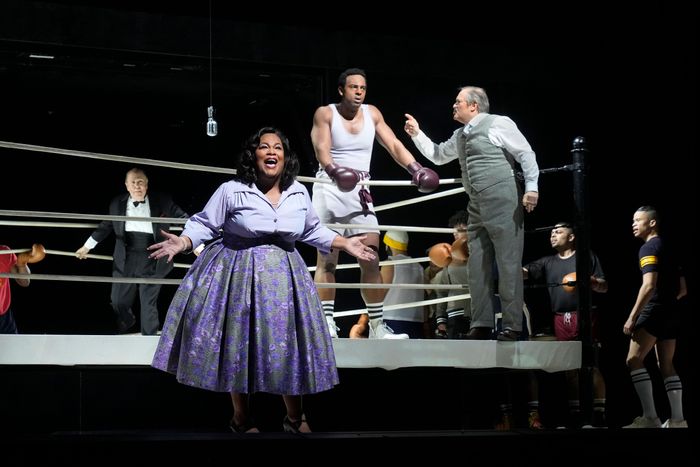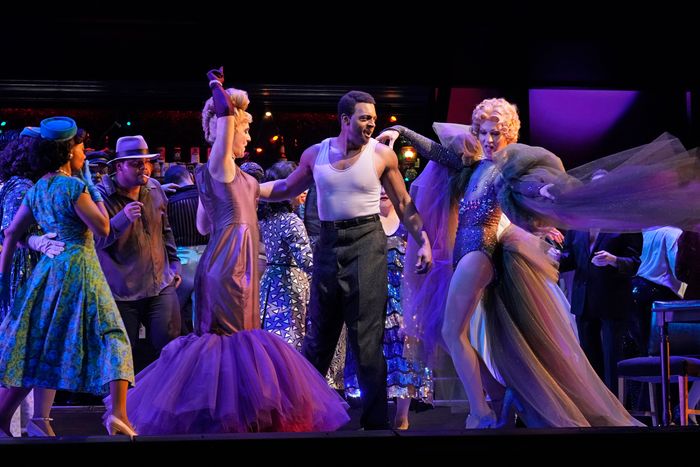
Terence Blanchard’s Champion is a boxing opera, and his score keeps changing pace, bouncing lightly on the balls of its feet or pummeling a point when the plot demands it. Ambition, opportunism, sexual insecurity, cruelty, and regret, crystallized in a spasm of violence — all the genre’s traditional ingredients are there in Blanchard’s first opera, which arrives at the Met in a revised production a decade after its premiere at Opera Theatre of St. Louis.
Based on the life of the real Emile Griffith, a welterweight champ in the 1960s, it opens with the title character as an addled old man, sung with noble pathos by Eric Owens. As he struggles to get his shoes on, you can hear both his regretful plod and a memory of the long-ago dance. In a series of flashbacks, Owens hands off to Ryan Speedo Green, who sings the younger Emile at the height of his charisma and fire, his vocal strength shot through with gentleness and shame. We see him as a kid from St. Thomas with talents for millinery and baseball, who disembarks in 1950s New York and gets drafted into the world of boxing. The opera, like the real athlete’s life, hinges on the day in 1962 when Griffith’s opponent Benny Paret riled him up with homophobic taunts and Griffith pummeled him to death in the 13th round on national TV.
The story is thinner than its creators would have us believe: Once we’ve witnessed Emile’s triumphs and sexual explorations, and the lethal seven-second rat-tat-tat of 17 blows that come just before intermission, all that’s left is disappointment and decline. Michael Cristofer pares back the libretto’s language to singsong monosyllables and rhymes that at times approach moon-June-spoon levels of sophistication and rarely open a window into the characters’ interior lives. Old Emile is trapped in his own confusion, young Emile in his performance of torment. In his big Act II aria, Emile’s manager Howie (Paul Groves) reminds us of a quarter-twist in the plot: Paret suffered head trauma even before the bout, a fact the newspapers had glossed over. It’s not enough to lift an opera that seems bitter about a sport that Blanchard has claimed to love. By the final curtain, you wind up feeling that the wages of boxing are dementia and death.
Still, Champion kicks up plenty of glory along the way. Blanchard is a master at matching color and pace, finding the perfect shade of indigo for a blue mood or the right brass blat to punctuate an ironic line. Every once in a while, his score reaches its ideal state and gels into a crackling, slinky, liquid substance that vibrates with dangerous energy. As an orchestrator, he has a taste for lushness, and the Met’s large and flexible orchestra gives him the resources to indulge. He’s smart enough to deny that urge. One of the most effective moments comes when he hushes the hundreds of players and voices at his disposal and accompanies Latonia Moore’s thrilling flame thrower of a voice with nothing but a plucked bass. She sings the role of Emile’s mother, who abandoned him and her other children. In her volatile mixture of quiet and heat, you can hear pride, self-loathing, desire, and the will to survive. Unfortunately, these passages are rare and precious in this score, and they come at the cost of long stretches of vamping, repetitiveness, and tunes that shuffle rather than soar. The action pauses when Green, with gloves on and pecs out, sings the aria “What Makes a Man a Man.” That’s where Blanchard’s inventiveness trudges just when you want it to take flight, and the melody circles back on itself.
This is Blanchard’s second opera to be performed at the Met, after Fire Shut Up in My Bones opened the season in 2021. Written ten years after Champion, that is a nimbler feat of musical storytelling, using many of the same ingredients: Moore as mother; a grown man observing his child self; soliloquies of masculine self-doubt; and swirling dance numbers propelled by the phenomenal drumming of Jeff “Tain” Watts. Snaking through both projects is a chameleonic kind of jazz that changes shape and hue to suit the situation, insinuating itself frictionlessly into the heart of the Met orchestra. The urge to “combine” jazz and classical traditions goes back more than 100 years; we can stop trying to figure out where one leaves off and the other begins. Blanchard calls Champion an “opera in jazz,” but it’s really just an opera, full stop. Jazz is a medium, a tool, and a set of allusions. No introductions needed.
Many canonical works that have thrived on the stage for a couple of centuries are equally, if not more, erratic than this; opera fans never seem to mind waiting for the good bits. And the Met has thrown Champion a rousing party. Yannick Nézet-Séguin steers the orchestra and chorus through all the many shifts from darkness to dazzle, shimmy, and grind. Director James Robinson narrates the action with canny use of projections, lighting, and a rotating ring. He also makes the most of the singers’ physicality: Green’s tightly coiled grace, Moore’s sexy defiance, Eric Greene’s menace in the role of Benny Paret, and Stephanie Blythe’s raunchy swagger and trombonelike mezzo-soprano as the owner of a gay bar where Emile finds a glint of tenuous happiness.
The choreographer Camille A. Brown enlivens the show with big dances that, though adrenalized and athletic, never approach the exhilarating explosiveness of the fraternity stomp in Fire. The burden of maintaining the excitement level sometimes falls on her set pieces. In one flashback, we see the child Emile being punished; he’s forced to hoist a cinder block and hold it there, Atlas-like, in the tropical heat of St. Thomas. When the music pales and the characters grow brittle, Brown’s dancers sweat mightily to keep a heavy show aloft.



